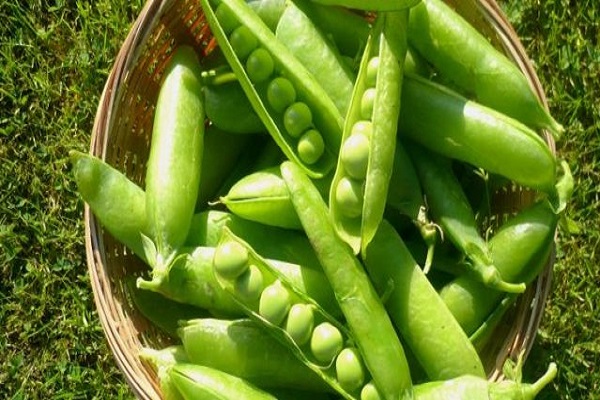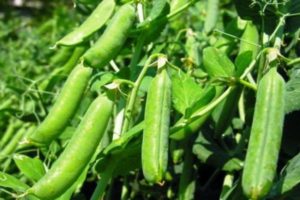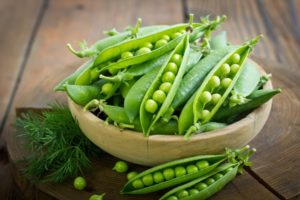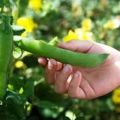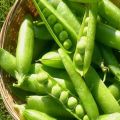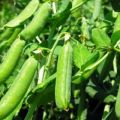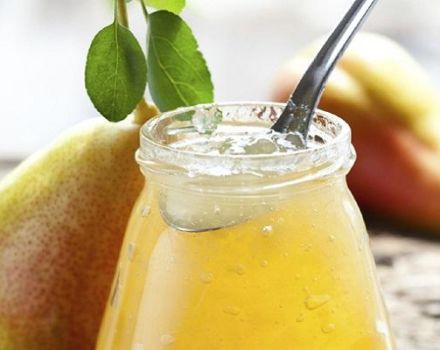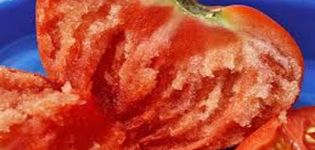How to grow and care for peas using modern technology
Peas are a common legume with a high nutritional value. It is especially appreciated for its high protein content (from 26 to 30%). In this respect, it can be compared to meat, only vegetable protein is better absorbed by the human body. In addition, peas are rich in carbohydrates, vitamins (groups B, C, A, PP) and trace elements (phosphorus, potassium, manganese, iron).
Peas are unpretentious, bears fruit in almost any conditions. But to get a rich harvest, you need to know how peas grow and what are the features of their cultivation.
Peas: characteristics of the culture
Peas (Pisum) are an annual herb of the legume family (Fabaceae) with a weak rounded-faceted lodging creeping stem, growing in length from 0.2 to 2.5 m. There are standard varieties in which a strongly thickened stem does not branch or lodge. The branched root system of this culture has a pivotal type and goes deep into the soil. Beneficial nodule bacteria develop on the roots and in their immediate vicinity, which absorb and accumulate nitrogen from the air, thereby enriching the soil with it.
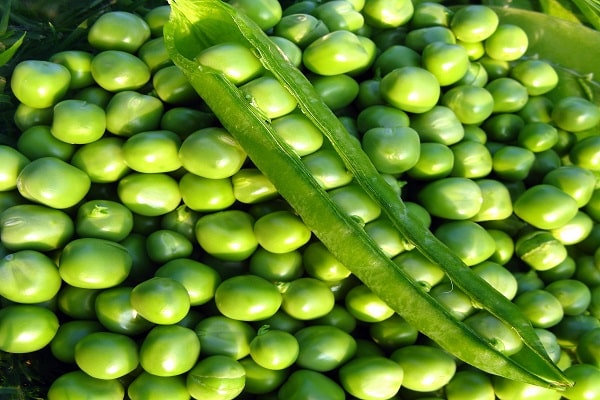
Compound pinnate leaves consist of 2-3 pairs of small elongated bluish-green leaf plates. The petiole of each leaf ends in a branchy thin mustache, with the help of which the peas cling to the support or neighboring plants. White, pinkish or purple moth-type flowers are located in leaf axils in 1 or 2. In early ripening varieties the peduncle appears after 6-7 leaves, in later varieties - after 12-23 (depending on the period of maturity).
The culture is self-pollinating, a pod develops in place of the flower. A straight or curved cylindrical bob consists of 2 valves, between which smooth or wrinkled peas (from 3 to 10 pieces) are placed in 1 row. The ripening period of peas can be different (from 55 to 100 days after planting).
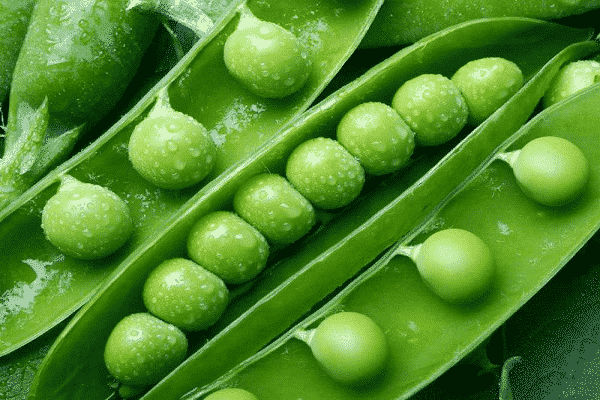
All varieties of this culture are divided into 3 groups:
- Peeling. The leaves are covered with a dense parchment layer from the inside and are not eaten. Only green, smooth, shiny peas are used for canning. The most popular varieties are: Alpha, Early 301, Atlant, Vera, Viola, Emerald and others.
- Sugar (leguminous).Delicate leaves break easily, since they do not have an inner leathery-fibrous layer. The beans are juicy, tasty and pulpy. The entire pod is used for food. Grades: Sugar cerebral 6, Inexhaustible 195, Sugar, De Grass 68-28, Zhegalova 112 and others.
- Semi-sugar. At first, the pods are tender and crunchy, the young beans are used in conjunction with the shutters. With age, a hard parchment layer appears in the places where the halves are fastened. The variety Karagandinsky 1053 is grown on the territory of Russia.
All varieties of peas are grown using the same technology and are not particularly difficult. But there are several important points to consider.
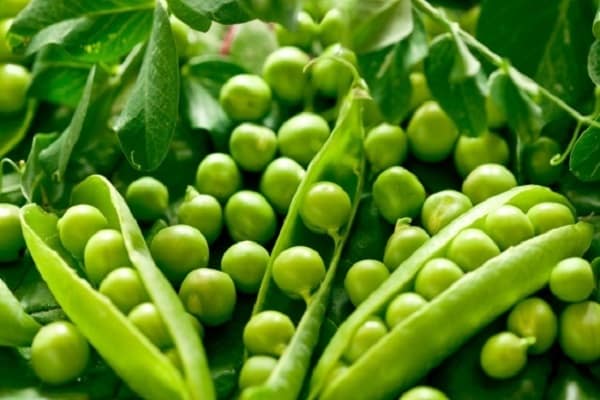
Choosing a place for planting peas in the garden
For peas, a sunny, well-lit area, windless and quiet is selected. Strong gusts of wind can break fragile stems. This crop can be placed along the fence or near the wall of the house, along which the stems will rise up. The plant tolerates light partial shade, but bears fruit better and more abundantly when all the foliage is well illuminated by the sun.
Some vegetable growers practice sowing peas in the trunks of large fruit trees (apple trees, pears and others), where they first pour a nutritious soil mixture from fertile garden soil and humus with a layer of at least 10-15 cm. Growing peas in the country, in the garden or in the garden is within our power any novice gardener, subject to simple rules.
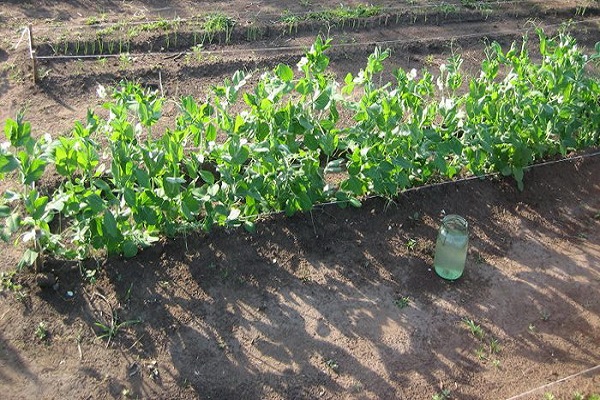
Climatic conditions for growing peas
To get an early and bountiful harvest, you need to try to create optimal conditions for growing peas. The culture loves good moisture, therefore, for the emergence of friendly shoots, seeds are planted in moist soil. Watering well and regularly will allow the plant to grow quickly and increase yields. Constant moderate humidity is especially necessary during the period of budding, flowering and fruit setting. With a lack of moisture, the pea bush sheds buds and ovary.
Peas can tolerate short-term droughts because the long taproot uses moisture from deep-seated soil layers (over 1 m). But he does not like the close location of cold groundwater, since the root system can rot.
This legume is cold-resistant, its seeds germinate already at + 5 ° C. Seedlings can survive short-term frosts down to -6 ... -4 ° С. During the formation of the ovary, the optimal temperature indicators should be in the range of + 13 ... + 15 ° С, for the rapid growth of beans, a temperature of at least + 17 ... + 22 ° С is required.
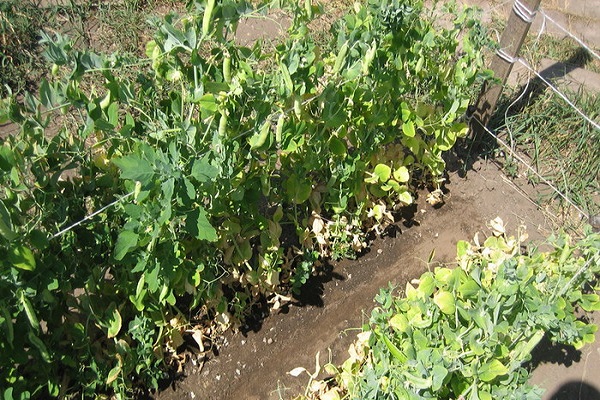
What kind of soil do peas like?
Peas are undemanding to the composition of the soil, but they will develop better and bear fruit more abundantly on loose, moderately moist loams and sandy loams with a sufficient content of phosphorus and potassium. When digging, it is recommended to add coarse river sand and humus to clayey heavy soil (1 bucket per 1 m²). In sandy soil, which does not retain moisture and fertilizers well, you need to add clay to increase moisture capacity (1 bucket per 1 m²).
The culture prefers soils with a neutral or slightly alkaline reaction, therefore acidic soils must be deoxidized with fluff or dolomite flour (300-400 g per 1 m²). Too rich and fertilized soils are also harmful to peas, since an excess of nutrients provokes the rapid growth of tops. In this case, the pods will be small and few in number. For specimens from which seeds will be collected for propagation, the soil is prepared especially carefully.
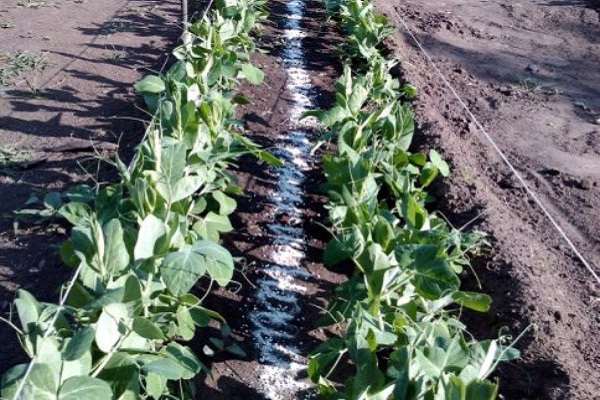
The best neighbors of peas
The crop yield is strongly influenced by which plants were cultivated in this place in the previous year. Peas grow well after early potatoes, pumpkin (squash, pumpkin, cucumber), cabbage, tomatoes. He will feel great in the garden next to corn, nightshades (potatoes), crucifers (cabbage, radishes).Other legumes (beans, chickpeas, soybeans, lentils, and others) are bad precursors for this crop. With proper crop rotation, peas are planted in the same area no earlier than 3-4 years later.
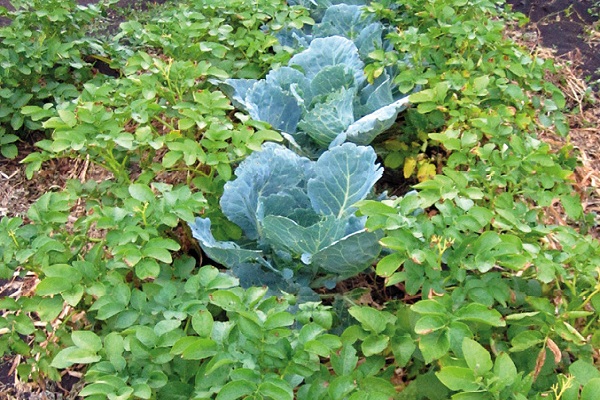
Features of planting peas at their summer cottage
Peas are cultivated industrially in large volumes in many regions of the Russian Federation, they are grown in Russia, India, Greece, America, Japan, Ukraine and other countries. In the past few years, our country has come out on top in the export of this culture.
However, when planting this plant in a garden plot or in a vegetable garden, you need to take into account a number of important points and pay special attention to the correct preparation of the soil in the garden and the preliminary processing of seed material.
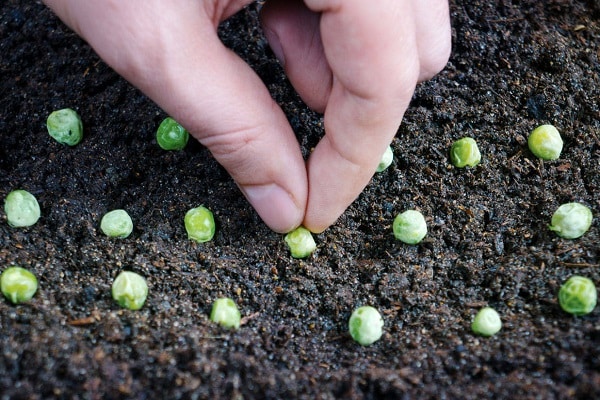
How to prepare the soil for planting peas?
In order for the peas to grow faster and begin to bear fruit, experienced vegetable growers recommend preparing a bed under planting peas in advance in the fall. When digging a site, it is necessary to add potassium salt (30-40 g per 1 m²) and superphosphate (50-60 g per 1 m²). The plant responds well to soil fertilization with compost or rotted manure (4-5 kg per 1 m²).
This culture does not tolerate fresh manure, but it grows well in the place that was fertilized in the previous year for its predecessors.
Peas need small doses of nitrogenous fertilizers; in the spring, just before planting, add 2-3 g of ammonium nitrate per 1 m² to the ground. Sowing can be done with dry and hatched seeds. With preliminary germination, the germination rate will be much higher.
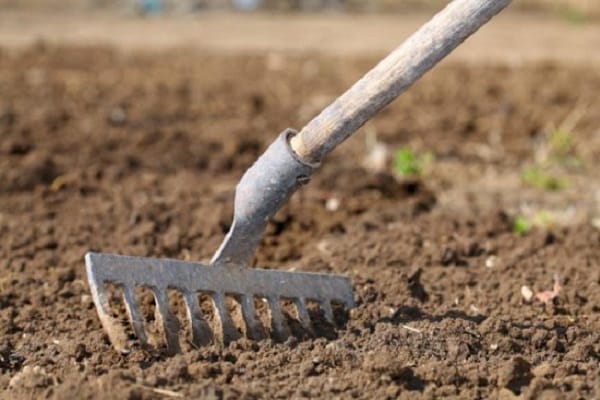
Preparing peas for planting
Preliminary preparation and processing of pea seeds before planting consists in the following manipulations:
- seed material is sorted out, leaving only the highest quality and healthiest (all damaged ones are thrown away);
- the seeds are soaked in warm water for 16-20 hours to swell, the liquid is changed every 4-5 hours;
- the water is drained, the seeds are wrapped in a damp cloth and left for 2-3 days until pecking (the cloth is periodically moistened, it cannot be allowed to dry out);
- to accelerate the appearance of sprouts, you can treat the seeds with any growth stimulator (Epin, Novosil and others).

Before sowing, dry peas are recommended to be slightly warmed up in a warm (+ 40 ... + 45 ° C) boric acid solution (1 g per 5 l of water) for 5-7 minutes. In the industrial method of cultivation of peas, the seed material is not soaked, but is treated with pesticides (pickled) and microelements to increase resistance to diseases and accelerate the emergence of seedlings.
How to sow peas correctly?
The correct cultivation technology for sowing peas provides for the following actions when sowing it:
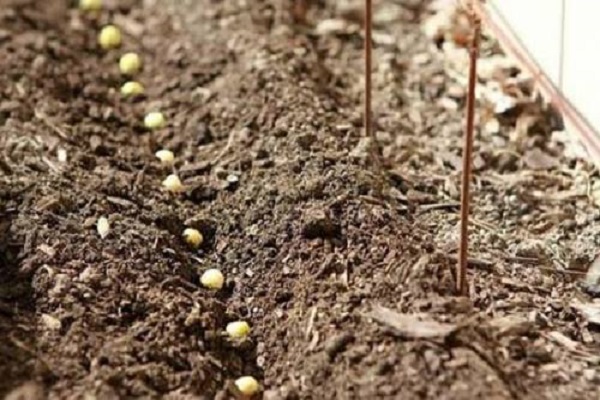
- on a prepared bed, several furrows are made 7-9 cm deep at a distance of 15-20 cm from each other (for tall varieties, the distance between rows is about 30-35 cm);
- a little mixture of humus with wood ash is poured at the bottom of each furrow, then sprinkled with soil;
- furrows are watered abundantly with water;
- seeds are placed in the furrows to a depth of 5-6 cm, leaving 5-7 cm between them (in heavy wet soils, the seeding depth is about 3-4 cm);
- covered with earth and slightly compacted.
To prevent the crops from being pecked by birds, it is recommended to cover the bed with a fine mesh or light-transmitting covering material.

Pea cultivation technology, features of plant care
Peas, the cultivation and care of which after sowing are especially important, will bear fruit better if all the rules of agricultural technology are observed. The timing of ripening and crop yield is influenced by the correct irrigation regime, loosening the soil, removing weeds, as well as tying bushes to a trellis or support.

First steps after sowing
The technology for growing peas involves planting it in moist soil, since the plant will quickly die with a lack of moisture, even without having time to rise. At the first time after sowing, it is necessary to carefully monitor the regularity and timeliness of watering.Before budding, water is watered once a week, during flowering and fruiting, watering is carried out at least 2 times every 5-7 days. In dry times, the amount of watering is increased.
Further care in the open field for this legume is to provide it with a sufficient amount of moisture. This is important throughout the growing season as the fruits appear unevenly. When the pods are already ripening in the lower part of the plant, its top continues to grow and form buds. But excessive moisture is also harmful, as it can provoke the development of fungal diseases.
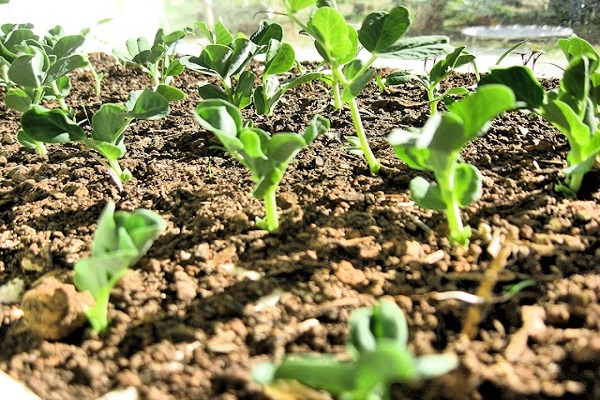
Soil care
The soil under the peas must always be kept in a loose state, since only in this case the required amount of oxygen will be supplied to the roots (with its deficiency, nodule bacteria develop poorly). During the period of active growth, close attention is paid to loosening the row spacings. The first time this procedure is carried out 10-14 days after planting, when young plants reach a height of 6-7 cm and form 5-6 leaves.
The soil between the rows is loosened (harrowed) to a depth of 7–8 cm and the plants are slightly spud. In order not to damage the fragile root system of pea bushes, it is recommended to do this before watering, while the ground is still dry. Simultaneously with loosening, weeding is carried out so that weeds do not take away nutrients from the peas. In order to avoid the formation of a dense earthen crust after watering, the plantings must be loosened and mulched with humus, straw, sawdust or peat.
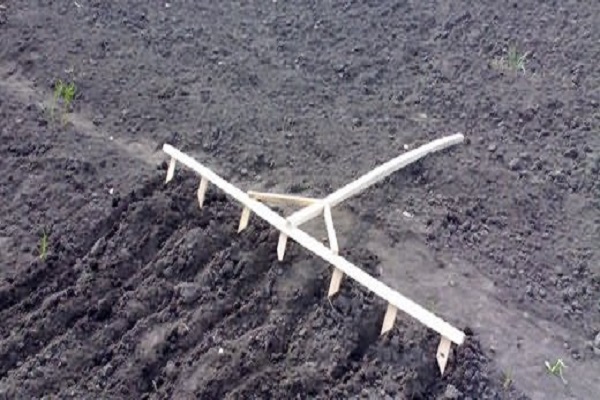
Pea feeding features
To increase yields, stimulate flowering and better formation of the ovary, planting peas must be fertilized. The newly emerged seedlings, while the nitrogen-fixing bacteria still do not work well, are fed with infusion of weeds (1 kg of any grass for 1 bucket of water) so that the plants do not suffer from a lack of nitrogen. For the same purpose, plantings are watered with a solution of a mullein (1:10) with the addition of nitrophoska (1 tbsp. L. Per 10 l of water).
During the formation of buds and the setting of pods, the culture is fertilized with any mineral complex (30 g per 10 l). When the plant blooms profusely, it is recommended to feed the peas with dry granules (25 g per 1 m²). With the industrial method of cultivating this crop, when it is grown in large areas, varieties that are undemanding to nutrition are used that do not need feeding.
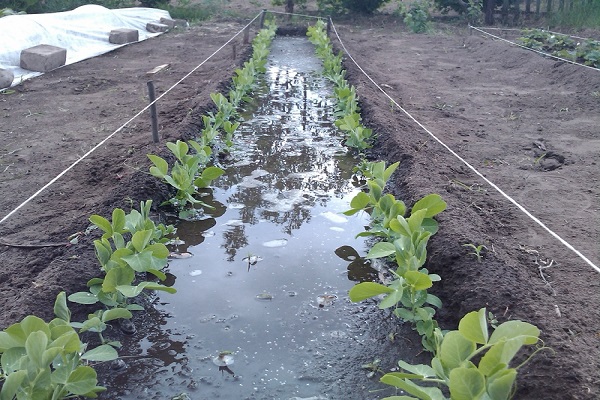
Garter bushes
The procedure for tying bushes is included in the list of mandatory measures for caring for pea crops. If this is not done in time, the weak stems will fall to the ground from the weight of the fruit and their own weight. Lying lashes are not ventilated and can rot, moreover, much less ovaries are formed on them. When placed vertically, the ground part of the culture is well warmed up and blown by the wind, which avoids a large number of diseases.
After the appearance of the first whiskers, when the seedlings reach a height of 7-10 cm, it is imperative to tie up young plants. There are several ways to install the support:
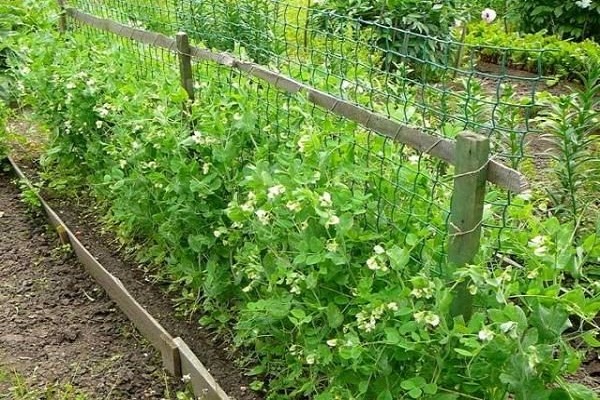
- Wooden stakes, metal rods or just branches are stuck along the row at a distance of 1-1.5 m from each other. A rope or wire is stretched horizontally between the stakes, on which the whips are placed. The rope is stretched along the entire perimeter in several tiers at different heights.
- A plastic mesh is installed between 2 adjacent rows, clinging to which the peas will stretch up.
- Seeds are sown along the perimeter of the hole, in the center of which a support rod is then placed.
- Supports (sticks, twigs, branches) are simply stuck along the furrows.
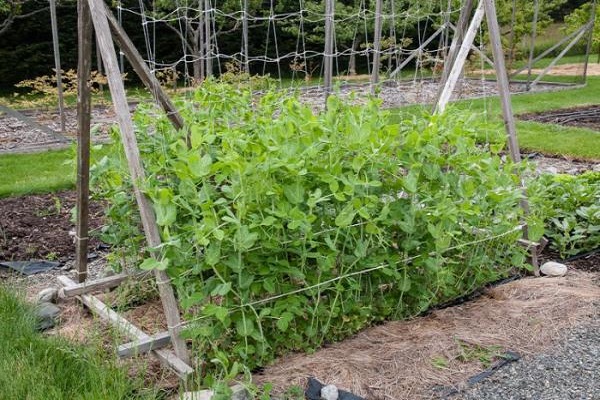
The main diseases and pests of peas
Cultivation of peas in the open field is sometimes accompanied by damage to the plantings by various diseases and pests.
Most often, the culture is exposed to such diseases:
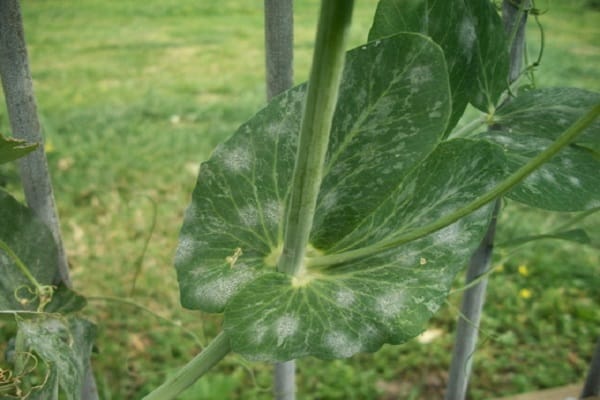
- Powdery mildew. It develops due to the strong thickening of crops and excess moisture.Loose white spots form on the upper part of the leaf plates, spores are located on the lower side. Plaque covers the entire green mass, then the stems and leaves die. For treatment, an infusion of sow thistle is used (0.3 kg per 10 liters of water, insisted for 8-10 hours). Sprayed twice with a break of 5-7 days.
- Mosaic. The plant develops poorly, the leaves become serrated and curly. An incurable disease, all affected bushes are immediately destroyed.
- Ascochitis. It manifests itself as dark brown fringed spots on the leaves. The plant dies. The fruits that have managed to ripen are unsuitable for food.
- Rust. Yellow spots appear on the top of the leaf surface, below - a characteristic yellow, loose bloom containing spores. The bush grows poorly, dies over time. To combat, spraying with Bordeaux liquid (1%) or sulfur-containing preparations is used.
Peas are sometimes attacked by such pests:
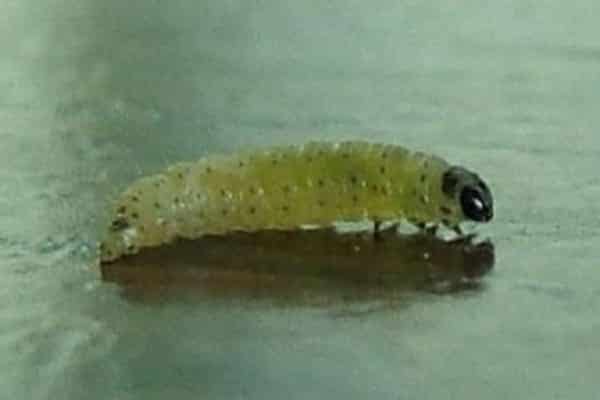
- Pea moth (leaf roll). Caterpillars gnaw and damage peas. For the fight, garlic infusion (20 g per 1 l), a decoction of tomato tops (3 kg per 10 l) and dusting with tobacco dust are used.
- Nodule weevil. The insect eats away the growth point (top), the larvae eat the roots and pods. The plantings are sprinkled with wood ash and tobacco.
- Pea aphid. It sucks sap from all parts of the plant. The stems wither, the flowers fall off. The bushes are washed with soapy water (250-300 g per 1 bucket of water), treated with acaricidal preparations (Iskra, Fastak, Fitoverm and others).
- Pea weevil. The larva of the black bruchus beetle hibernates in the seed, then gnaws at the pods and eats the peas. The fight against it consists in planting early and in careful selection of seeds, which are treated with a solution of sodium chloride (3%) before sowing. Pop-up instances are thrown away.
In case of severe damage, special systemic drugs are used (fungicides and insecticides). As a preventive measure, it is recommended: compliance with crop rotation, deep autumn plowing, careful destruction of plant residues and good planting care.
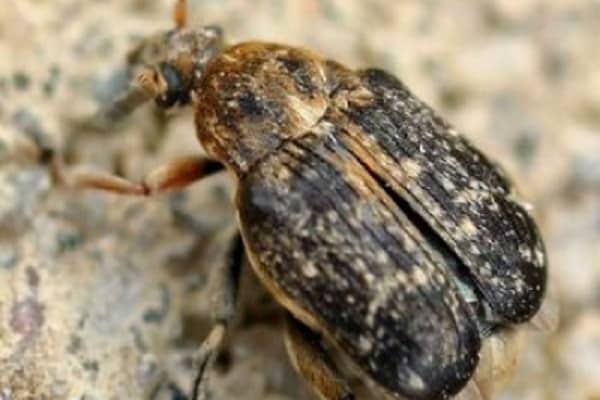
Peas: how to get a rich harvest
In order to enjoy a bountiful harvest for as long as possible, peas must be harvested on time. If the ripened pods are not picked on time, the next fruits will ripen later. Regular, constant collection stimulates fruiting.
The first pods at the stage of milky ripeness are harvested about 21-25 days after flowering. The timing is determined by the variety. Sugar varieties, which are eaten together with shoulder blades, are plucked 12-15 days after the mass flowering. Fresh green peas of brain varieties are ready in 18-23 days. The lower pods ripen first.
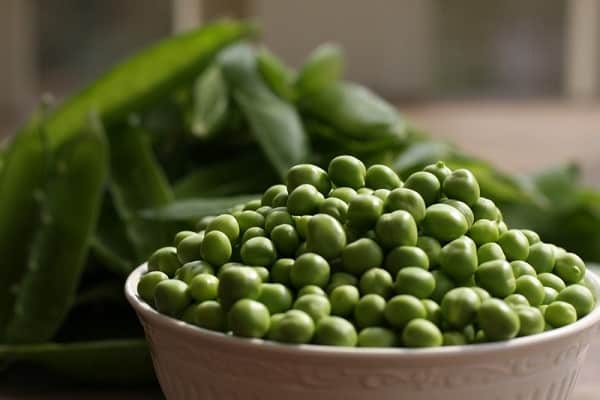
It is better to harvest in the morning, when the air is still cool, then the beans will not wither. Cleaning is done once every 2-3 days in good warm weather and once every 4-5 days in cool and cloudy weather. Experienced gardeners practice sowing peas with different ripening periods and stage-by-stage planting of seeds in the ground at intervals of 15-20 days. The earlier the planting was made, the earlier you can get the harvest.
